Corn or maize and it’s bi-products are today widely used ingredients in so many products we consume. This common grain is cultivated all over the world now that we may no longer even wonder where it may have originated. If you drive through the Midwest in the USA, you will see acres upon acres of corn fields. This region is often referred to as the breadbasket of America. In some farming regions, corn fields can stretch as far as the eye can see. The USA and China are the two biggest producers of corn today. The bi products of maize range from sweet corn, corn syrup, corn starch, liquid glucose, high maltose syrup, corn flakes, popcorn to corn oil and corn ethanol for fuel. A large percentage of the corn grown today is also used for animal stock feeds.

Though Maize was first cultivated between 500-1000 years ago by native Americans in the areas of New Mexico and Arizona, it is not the original source of the corn plant. The ancient native peoples of Mexico were probably the first cultivators of this cereal grain around 9000 years ago. In time, maize was grown further south on the American continent as it was transported via the Andes and became a staple food to other cultures. The Aztec and Maya recognized the importance of the mahiz plant to their existence and even had deities for the precious maize. Easily cultivated in large fields or even smaller terraced mountainous plots, maize became an all important food source in the diets of many mesoamerican cultures. Maize was used for alcoholic ceremonial drinks and was dried and pounded into masa which is the key ingredient for making tortillas and tamales. In essence, a successful maize production was key to the prosperous existence of early mesoamericans.
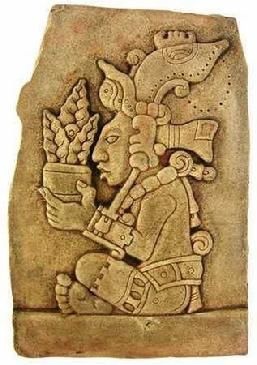
Mayan God of Maize
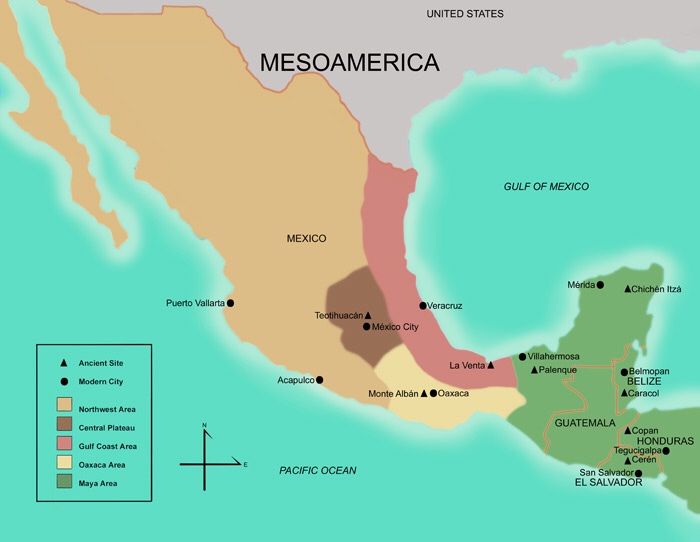
.
After 1492, the Spanish settlers in the Americas learned about maize from the indigenous people of the land. Although they were at first hesitant to consume corn due to superstitious fears, maize was accepted and the grain made its way to Europe via traders and explorers eager to show their findings from the “New World”. The Portuguese introduced maize to Africa in the 16th century and it has since become a very important staple to many of the countries on the African continent. Maize is cultivated all over the world and is an important food group for a large percentage of the global population.
In the Caribbean during the time of slavery, maize was a cheap and easily sourced food which was used to feed the massive working population. Allotments of dried corn, salt meat and salt fish were given to slaves as weekly food rations along with other vegetables such as breadfruit, root provisions and beans. Dried corn could be ground and became a staple for making porridges and savory dishes. Some well loved Caribbean favorites passed down through generations are cornmeal based. In Barbados, coucou is one of these dishes. It is made with finely ground yellow cornmeal, seasonings and okra and molded into a bowl shape. It is eaten with flying fish or stewed meat. In Haiti, maïs moulu et pois en sauce is a delicious favorite. It’s a polenta style savory preparation of slow cooking and stirring the ground corn until it becomes a velvety soft texture. Sometimes smoked herring is added to this mixture. Unlike Italian polenta recipes, the Haitian mayi moulen (in Creole) is not prepared with milk or cheese. Usually a tasty tomato based creole style sauce is served with the soft cornmeal. It can alternatively be cooked with the beans much like a peas and rice preparation. In many of the Caribbean islands, there are also fried breads made of finely ground corn meal like festival. A sweet treat called conkie is also a well known dessert made of cornmeal, coconut and spices tied in a banana leaf and steamed. Cornmeal pastels filled with ground meat, capers and raisins are delicious Trinidadian and Puerto Rican favorites. This Latin flavored delight is also wrapped in banana leaves and steamed.

Making pastels in my kitchen.
When I first moved to Haïti, I quickly realized that this was a country with a culture that had a love affair with corn. It is quite common to see roadside hawkers of maïs boukanné ( grilled corn) selling to hungry passers by. The Haïtian variety of maize is usually quite tough. The kernels are small and not very juicy. The slightly charred exterior gives a smoky flavor which is well loved by many. Haitian corn when dried, is perfect for making coarse ground maïs or corn meal. The cooked mayi moulen is soft and creamy and pairs well with spicy sauces or creamy beans. It is a more nutritious source of vitamins than rice and very appreciated in local cuisine. Corn based porridge or la bouillie is a milky preparation made with sugar and spices like cinnamon and cloves, is well loved by all ages. AK-100 pronounced ah-ka-san is another type of Haitian porridge or bouillie made from grated fermented corn. It is sold in bottles all over the country and can then be prepared with milk and spices. It is a weekend breakfast offering in Haïti.

Haitian AK-100 porridge with cinnamon and a drizzle of honey
I must admit that I am a recent convert to polenta, as I did not like it much in the past. For me it was a textural thing which I did not connect with in my early days here in Haïti. Cornmeal was not a staple growing up in Guyana, and we eat rice with most meals. My favorite way to use cornmeal is in a gratin. Recently I came up with this recipe and my family loved it. I also have made this gratin with a Mornay sauce and cubes of baked ham and sautéed mushrooms and it is also very delicious. I use the traditional way of preparing the ground cornmeal and then spread it onto a baking sheet. As it cools, the cornmeal hardens and can be sliced or cut into shapes very easily. I make a very highly seasoned tasty meat filling and a nice kick of hot pepper. An uber creamy, luscious cheese sauce is the key to marrying the cornmeal with the meat. The gratin is made with 2 layers of the mixture and then baked for 45 minutes until it is golden. In the oven, the components meld harmoniously together creating a wonderfully gooey thing of beauty.

Another form of gratin with polenta cubes, ham and mushroom
As the cornmeal has texture but not a bold flavor I rather like to use the Latin seasoning profile of Cilantro and the orange colored annatto powder in a packet of Sazon blend. The pimento slices, tomatoes and the hot pepper give a spicy zing and really make the dish pop. In a word, it’s awesome!! Try it and you will be convinced as I was that this is a fabulous way to prepare cornmeal. For my personal taste, cheese and cream make this polenta dish great and it screams love and home in every bite. It’s warm, unctuous and comforting. In my opinion it is perfect for a family dinner and yet sophisticated enough to be served to and appreciated by foodies!! If you’re lucky enough to have some leftovers, they heat up perfectly.
I urge you to try it for those you love. You won’t be disappointed!!
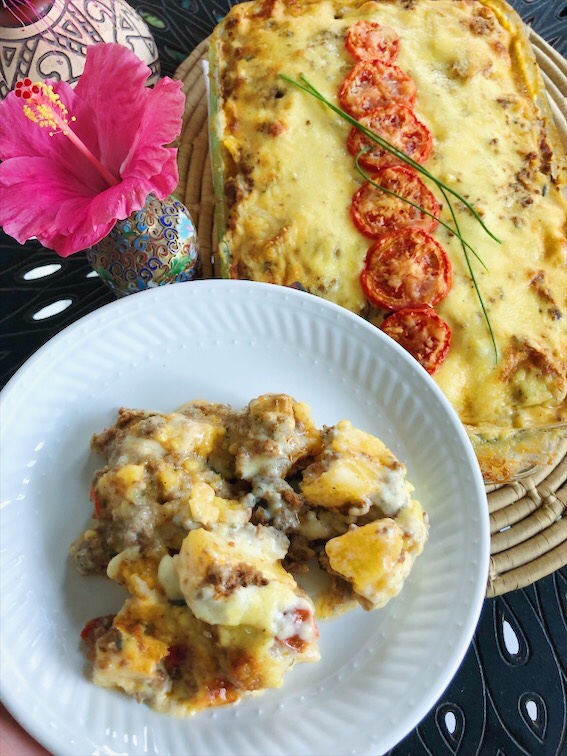
Cheesy polenta and ground beef gratin
Serves 6
Ingredients
Polenta( Mayi Moulen)
1 cup coarse yellow corn meal
4 1/2 cups water
1 small onion finely chopped 1/4 cup
1 garlic clove minced
1 tsp salt
1 tsp olive oil
Meat filling
1 1/2 lb Ground meat
1 onion chopped
1 tomato chopped
3 cloves garlic, crushed
1 hot pepper chopped * optional
1 tbsp Worcestershire sauce
2 tbsp ketchup
1 tsp mustard
6-8 mushrooms sliced
1 tsp thyme
1 tbsp olive oil
1 pack sazon with coriander and annatto* or a chicken bouillon cube
1 tsp black pepper
2 tbsp pimento slices
3 green onions, sliced
1 tbsp cognac or rum
béchamel sauce
1 cup cooking cream or half and half
1 cup milk
3 tbsp flour
2 tbsp butter
2 oz grated aged Edam cheese or Parmesan
4 oz gruyere or Swiss cheese grated
1 tsp Dijon mustard
A bit of grated nutmeg
Salt and pepper to taste
2 tbsp grated Edam or Parmesan for sprinkling on the top of the gratin
Method
Heat oil in a medium heavy based pot.
Add chopped onion and garlic and sauté until translucent but not brown.
Add 4 1/2 cups water and salt. Bring to a rapid boil.
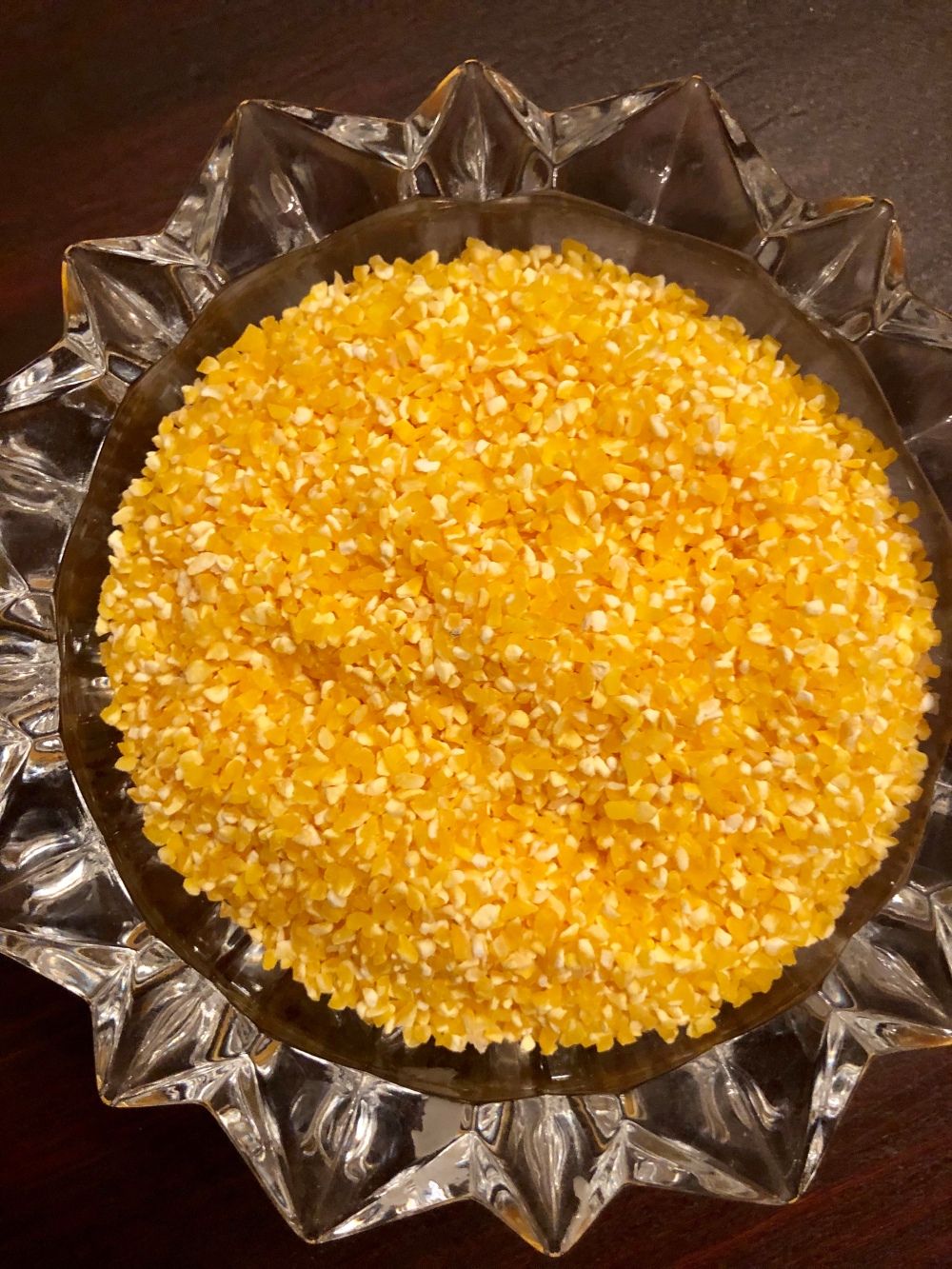
Coarse ground yellow cornmeal
Add corn meal in a slow stream, constantly whisking. Failure to do this step will make the cornmeal clump, so it is imperative to keep whisking.
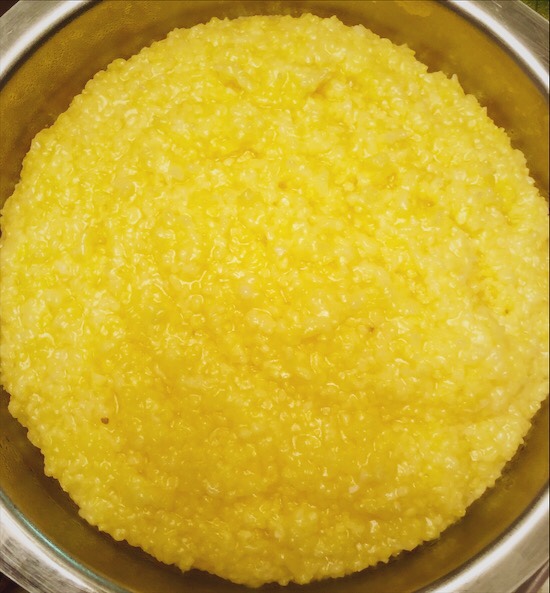
Mayi moulen
Lower heat and cook uncovered, stirring occasionally.
Cook for about 25 minutes or until cornmeal is tender and not runny. Sprinkle black pepper to taste.
Pour into a greased cookie tray 18×13”.
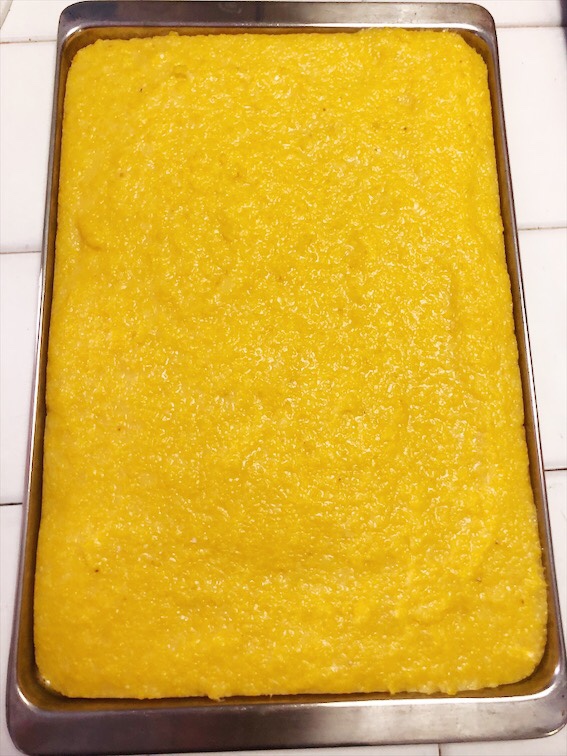
Cooling cooked cornmeal in a sheet tray to be cut into cubes
Allow to cool for 30 minutes.
When cool, slice the polenta into 1” cubes. You may use about 3/4 of this quantity of the polenta, but you can save the rest for later use. It is great pan fried in olive oil for a crispy alternate use.

Cutting circles of cornmeal with a portion of polenta
Sauté the onion & garlic in olive oil. Add the ground meat and cook together breaking up clumps until browned.
Add the chopped tomatoes, chopped pimento slices, sliced mushrooms, thyme and packet of Latin style sazón.
Add the ketchup, mustard and Worcestershire sauce to combine. Add the hot pepper if using. Pour in cognac and sprinkle chopped green onions.
Taste for salt and pepper.
Simmer 5-10 minutes.
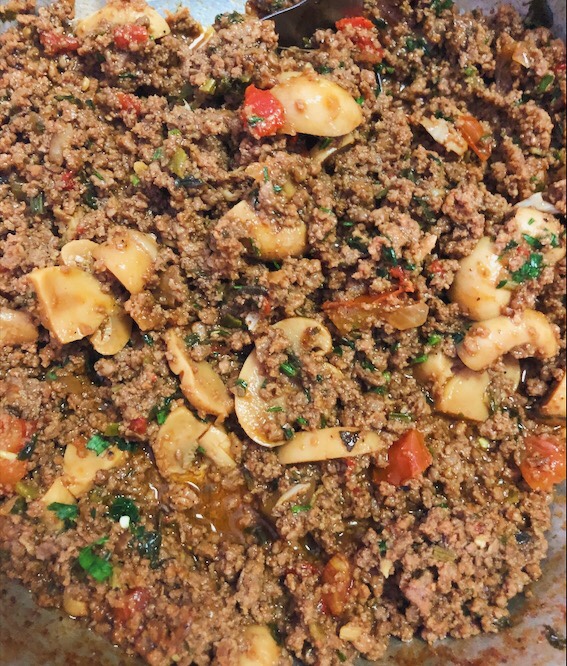
Ground beef and mushroom filling
Bechamel
In a heavy medium pot on medium low heat melt butter. Add the flour and cook together stirring constantly with a wooden spoon or spatula for about 5 minutes to form a roux.
Pour over milk bit by bit to dissolve the roux. Whisk the mixture well to incorporate . Make sure that you breakdown all of the flour bits at this point or you will have lumps in your sauce.
Add the cooking cream and combine.
Add grated cheese and stir together to incorporate and melt. Add mustard, a pinch of black pepper and a grating of nutmeg.
Once the cheese has all melted and the béchamel is smooth, remove from the heat.

Making the béchamel sauce with cheese
To assemble
Grease a large baking dish 8x12x2”
Ladle a bit of the béchamel sauce on the base of the dish. You will have 3 layers of béchamel, so be careful to divvy up the portions accordingly. You will start and end with the cheese sauce.

Assembling the gratin
Put a layer of polenta cubes over the cheese sauce.
Add half of the meat and mushroom mixture of the polenta.
Ladle 1/2 béchamel sauce over the meat. Continue the process again ending with béchamel.
Sprinkle with some reserved cheese.

Ready for the oven
If the gratin fills the dish, you may want to place a baking sheet under as the sauce could possibly bubble over during the baking time. Do not fill the gratin higher than the sides. It’s a good measure to be slightly below the height of the dish to avoid spills.
Heat oven to 375 degrees and bake for 45 minutes or until bubbling and golden.

The baked cornmeal gratin
Serve warm
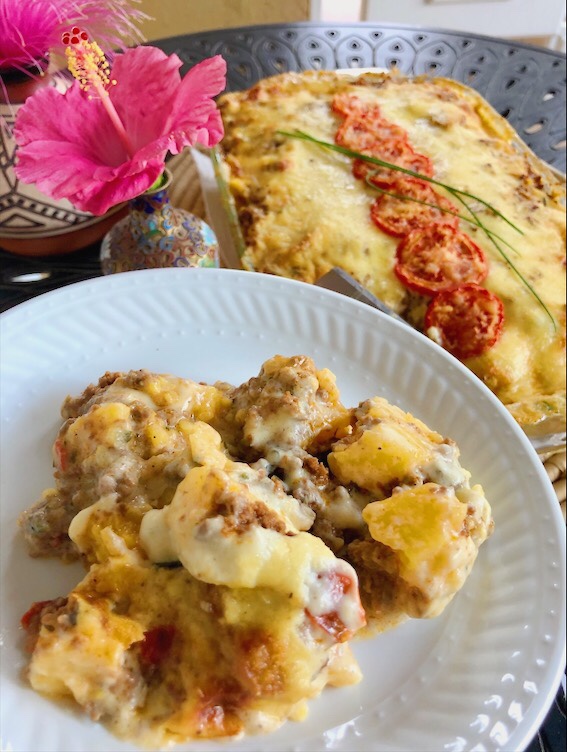
Cheesy goodness with such wonderful flavors